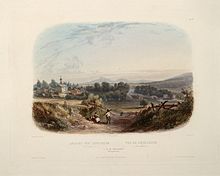Karl Bodmer
Johann Carl Bodmer[1] (11 February 1809 – 30 October 1893) was a Swiss-French printmaker, etcher, lithographer, zinc engraver, draughtsman, painter, illustrator, and hunter.After he moved to France following his return from an expedition in the American West, he became a member of the Barbizon School, a French landscape painting group from the mid-19th century.In a letter on that date, Prince Max wrote to his brother that Bodmer "is a lively, very good man and companion, seems well educated, and is very pleasant and very suitable for me; I am glad I picked him."[citation needed] Arriving in Boston, Massachusetts, on 4 July, the three encountered hardships and delays caused largely by a cholera epidemic in the eastern states.Prince Max had planned to spend only a few days in New Harmony, but his stay "was prolonged by serious indisposition, nearly resembling cholera, to a four months' winter residence.Bodmer had extensively documented the journey with visual images, while Prince Max took copious notes for the book he intended to write.The Prince had these images incorporated into his book of the expedition, which was first published in German in Koblenz as Reise in das innere Nord-Amerika in den Jahren 1832 bis 1834 in two volumes from 1839 to 1841.Among his well-known works from this period was La Foret en Hiver (Interior of the forest in winter), exhibited at the Salon 1850 in Paris.[citation needed] His portraits were the first accurate portrayal of western Indians in their homelands, and they are considered remarkable for their careful detail and sensitivity to the personalities of his sitters.[7] Bodmer's work is recognised as among the most accurate painted images ever made of Native Americans, their culture and artifacts, and of the scenery of the pristine "Old West".




WoodburytypeZürichFrenchPrince Maximilian of Wied-NeuwiedprintmakeretcherlithographerdraughtsmanaquatintsBarbizon SchoolLegion of HonourAmerican frontierMaximilian zu Wied-NeuwiedMissouri RiverNative AmericansGermanEnglishHeinrich FüssliGabriel LoryNorth AmericaaquatintBethlehem, PennsylvaniaBivouacSwitzerlandKoblenzPrinz Maximilian zu Wied-NeuwiedBraziltaxidermistBostonMassachusettscholeraepidemicMichiganPittsburghMt. Vernon, IndianaNew Harmony, IndianaThomas SayCharles-Alexandre LesueurNew OrleansSt. LouiskeelboatFort Benton, MontanaFort ClarkMandanBarbizonFontainebleauClaude MonetChailly-en-BièreFontainebleau forestJoslyn Art MuseumOmaha, NebraskaHidatsa tribeMato-topeNorth America Native MuseumPhilip Gilbert HamertonJohn C. EwersHenri BeraldiWayback Machine